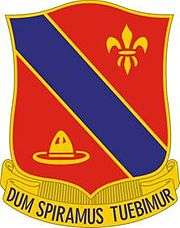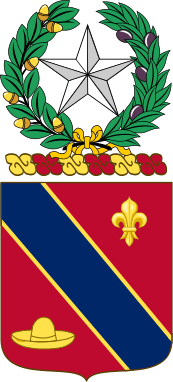133rd Field Artillery Regiment (United States)
| 133d field Artillery Regiment | |
|---|---|
|
Coat of arms | |
| Active | 1899 |
| Country |
|
| Allegiance |
|
| Branch | Texas National Guard |
| Type | Field artillery |
| Size | Regiment |
| Motto(s) | Dum Spiramus Tuebimur (While We Breathe, We Shall Defend) |
| Insignia | |
| Distinctive unit insignia |
 |
The 133rd Field Artillery Regiment is a field artillery regiment of the Army National Guard, first constituted in 1899.
History
The 133rd Field Artillery Regiment's lineage is carried by 1st Battalion, 133rd Field Artillery, a unit of the 72nd Infantry Brigade Combat Team, and 3rd Battalion, 133rd Field Artillery, a unit of the 56th Infantry Brigade Combat Team, both brigades of the 36th Infantry Division.
From August 2008 to August 2009 Charlie Battery deployed as a filler unit to 3rd BN 133rd Filed Artillery (56th IBCT) in support of Iraqi Freedom. C Battery was based out of COB Adder, Tallil, Iraq carrying out the mission of Convoy Security. During the deployment, C Battery conducted over 120 Convoy Security Missions. 1 Member of the Battery was awarded the Purple Heart for wounds sustained. C Battery redeployed in August 2009 and was returned to its organic Battalion. In 2011 Charlie Battery was deactivated, while 4th 133rd was reorganized into a HIMARS Battalion.
In October 2009, Headquarters and Headquarters Battery, Alpha Battery, and Bravo Battery from 1st Battalion, 133d Field Artillery were mobilized for service in Operation Iraqi Freedom as part of the 72nd Infantry Brigade Combat Team. After completing training at Camp McGregor, NM as detainee guard force units, HHB and A Battery were deployed to Camp Cropper, Iraq, with B Battery being sent to Camp Taji, Iraq. The brigade completed operations in Iraq in July and August 2010 and redeployed to the United States, with A Battery being the last unit in the brigade to return home.
Lineage
Organized 20 September 1899 in the Texas Volunteer Guard at El Paso as the Border Rifles and assigned to the 4th Infantry Regiment as Company B
(Texas Volunteer Guard redesignated 1 July 1903 as the Texas National Guard)
Expanded 18 July 1905 to form Companies B and K, 4th Infantry Regiment (Company B—hereafter separate lineage)
Company K, 4th Infantry Regiment, mustered into federal service 18 May 1916; mustered out of federal service 24 March 1917
Mustered into federal service 11 April 1917; drafted into federal service 5 August 1917
Reorganized and redesignated 15 October 1917 as Company G, 144th Infantry, an element of the 36th Division
Demobilized 21 June 1919 at Camp Bowie, Texas
Expanded, reorganized, and federally recognized 11 May 1922 in the Texas National Guard as the 2d Battalion, 141st Infantry, an element of the 36th Division (later redesignated as the 36th Infantry Division), with headquarters at El Paso
Inducted into federal service 25 November 1940 at home stations
Inactivated 22 December 1945 at Camp Patrick Henry, Virginia
Converted (less Companies F and G), reorganized, and federally recognized 2 December 1946 as the 696th Antiaircraft Artillery Automatic Weapons Battalion, with headquarters at El Paso; concurrently relieved from assignment to the 36th Infantry Division (Companies F and G, 141st Infantry-hereafter separate lineages)
Redesignated 1 May 1949 as the 136th Antiaircraft Artillery Automatic Weapons Battalion and assigned to the 36th Infantry Division
Redesignated 1 October 1953 as the 136th Antiaricraft Artillery Battalion
Consolidated 16 March 1959 with the 132d (see ANNEX 1), 133d (see ANNEX 2), and 155th (see ANNEX 3) Field Artillery Battalions to form the 133d Artillery, a parent regiment under the Combat Arms Regimental System, to consist of the 1st, 2d, 3d, 4th, and 5th Howitzer Battalions, elements of the 36th Infantry Division
Reorganized 1 March 1963 to consist of the 2d, 3d, 4th, and 5th Howitzer Battalions, elements of the 36th Infantry Division
Reorganized 1 November 1965 to consist of the 2d, 3d, and 5th Battalions, elements of the 36th Infantry Division, and the 4th Battalion, an element of the 36th Infantry Brigade
Reorganized 15 January 1968 to consist of the 1st Battalion, an element of the 71st Airborne Brigade, the 3d Battalion, and the 4th Battalion, an element of the 36th Infantry Brigade
Redesignated 1 May 1972 as the 133d Field Artillery
Reorganized 1 November 1973 to consist of the 1st, 3d, and 4th Battalions, elements of the 49th Armored Division
Reorganized 1 September 1979 to consist of the 1st, 3d, and 4th Battalions and Battery E, elements of the 49th Armored Division
Withdrawn 4 March 1987 from the Combat Arms Regimental System and reorganized under the United States Army Regimental System
Reorganized 1 September 1999 to consist of the 1st, 3d, and 4th Battalions, elements of the 49th Armored Division
- ANNEX 1
Constituted 5 May 1917 in the Texas National Guard as the 1st Battalion, 2d Field Artillery
Organized June–July 1917 in north central Texas
Drafted into federal service 5 August 1917
Reorganized and redesignated 15 October 1917 as the 1st Battalion, 131st Field Artillery, an element of the 36th Division
Demobilized 2 April 1919 at Camp Travis, Texas
Reorganized in 1922 in the Texas National Guard as the 1st Battalion, 131st Field Artillery, an element of the 36th Division; Headquarters federally recognized 29 October 1922 at Plainview
Inducted into federal service 25 November 1940 at home stations
Reorganized and redesignated 9 February 1942 as the 131st Field Artillery Battalion, an element of the 36th Infantry Division
Inactivated 26 December 1945 at Camp Patrick Henry, Virginia
Expanded 2 July 1946 to form the 131st and 132d Field Artillery Battalions, elements of the 36th Infantry Division (131st Field Artillery Battalion-hereafter separate lineage)
132d Field Artillery Battalion reorganized and federally recognized 10 July 1947 in western Texas with headquarters at Lubbock
- ANNEX 2
Organized in 1922 in the Texas National Guard from new and existing units as the 2d Battalion, 132d Field Artillery, an element of the 36th Division; Headquarters federally recognized 28 January 1923 at Corsicana
Inducted into federal service 25 November 1940 at home stations
Reorganized and redesignated 9 February 1942 as the 155th Field Artillery Battalion, an element of the 36th Infantry Division
Redesignated 5 November 1942 as the 133d Field Artillery Battalion
Inactivated 18 December 1945 at Camp Patrick Henry, Virginia
Reorganized and federally recognized 12 May 1947 with headquarters at Corsicana
- ANNEX 3
Constituted 5 May 1917 in the Texas National Guard as the 1st Field Artillery Organized 4 June 1917 with headquarters at Dallas
Drafted into federal service 5 August 1917
Redesignated 15 October 1917 as the 133d Field Artillery and assigned to the 36th Division
Demobilized 2 April 1919 at Camp Bowie, Texas
Reorganized 1 June 1936 in the Texas National Guard as the 133d Field Artillery and assigned to the 36th Division; Headquarters federally recognized 9 July 1936 at San Antonio
Inducted into federal service 25 November 1940 at home stations
Regiment broken up 9 February 1942 and its elements reorganized and redesignated as follows:
Headquarters disbanded
1st Battalion as the 133d Field Artillery Battalion, an element of the 36th Infantry Division
(Headquarters Battery consolidated with the Pioneer Company, 626th Tank Destroyer Battalion; 2d Battalion as the 2d Battalion, 202d Field Artillery—hereafter separate lineages)
133d Field Artillery Battalion redesignated 5 November 1942 as the 155th Field Artillery Battalion
Inactivated 18 December 1945 at Camp Patrick Henry, Virginia
Expanded 2 July 1946 to form the 155th Field Artillery Battalion, an element of the 36th Infantry Division, and the 749th Armored Ordnance Battalion, an element of the 49th Armored Division (749th Armored Ordnance Battalion—hereafter separate lineages)
155th Field Artillery Battalion consolidated with Headquarters, 133d Field Artillery (reconstituted 25 August 1945 in the Texas National Guard), and consolidated unit reorganized and federally recognized 10 February 1947 in central Texas as the 155th Field Artillery Battalion with headquarters at New Braunfels
Distinctive unit insignia
- Description
A Gold color metal and enamel device 1 1/8 inches (2.86 cm) in height overall consisting of a shield blazoned: Gules, a bend Azure fimbriated Or between a fleur-de-lis and a Mexican sombrero of the last. Attached below the shield a Gold motto scroll inscribed “DUM SPIRAMUS TUEBIMUR” in Blue letters.
- Symbolism
The shield is red for Artillery. The blue bend, taken from the Dallas family coat of arms, represents the descent of the organization from the Dallas Artillery Company, earlier known as the Queen City Guards. The sombrero is symbolic of the Mexican Border; the fleur-de-lis, service in France.
- Background
The distinctive unit insignia was originally approved for the 133d Field Artillery Regiment on 11 August 1937. It was redesignated for the 133d Field Artillery Battalion on 7 October 1942. It was redesignated for the 155th Field Artillery Battalion on 23 February 1943. The insignia was redesignated for the 749th Armored Ordnance Maintenance Battalion on 14 June 1951. It was redesignated for the 949th Armored Ordnance Maintenance Battalion on 17 August 1955. The insignia was redesignated for the 133d Field Artillery Regiment on 18 January 1989.
Coat of arms
Blazon
- Shield
Gules, a bend Azure fimbriated Or between a fleur-de-lis and a Mexican sombrero of the last.
- Crest
That for the regiments and separate battalions of the Texas Army National Guard: On a wreath of the colors Or and Gules a mullet Argent encircled by a garland of live oak and olive Proper. Motto DUM SPIRAMUS TUEBIMUR (While We Breathe, We Shall Defend).
Symbolism
- Shield
The shield is red for Artillery. The blue bend, taken from the Dallas family coat of arms, represents the descent of the organization from the Dallas Artillery Company, earlier known as the Queen City Guards. The sombrero is symbolic of the Mexican Border; the fleur-de-lis, service in France.
- Crest
The crest is that of the Texas Army National Guard.
Background
The coat of arms was originally approved for the 133d Field Artillery Regiment on 24 May 1937. It was redesignated for the 133d Field Artillery Battalion on 10 October 1942. It was redesignated for the 155th Field Artillery Battalion on 23 February 1943. The insignia was redesignated for the 749th Armored Ordnance Maintenance Battalion on 14 June 1951. It was redesignated for the 949th Armored Ordnance Maintenance Battalion on 17 August 1955. The insignia was redesignated for the 133d Field Artillery Regiment on 18 January 1989.
Current configuration
- 1st Battalion 133rd Field Artillery Regiment (United States)
- 3rd Battalion 133rd Field Artillery Regiment (United States)
- 4th Battalion 133rd Field Artillery Regiment (United States) (HIMARS)
See also
- Field Artillery Branch (United States)
- Coats of arms of U.S. Artillery Regiments
- Coats of arms of U.S. Infantry Regiments
References
![]() This article incorporates public domain material from the United States Army Institute of Heraldry document "133rd Field Artillery Regiment".
This article incorporates public domain material from the United States Army Institute of Heraldry document "133rd Field Artillery Regiment".
